U n i v e r s i t é Y O R K U n i v e r s i t y
ATKINSON FACULTY OF LIBERAL AND PROFESSIONAL STUDIES
SCHOOL OF ANALYTIC STUDIES & INFORMATION TECHNOLOGY
S C I E N C E A N D T E C H N O L O G Y S T U D I E S
STS 3700B 6.0 HISTORY OF COMPUTING AND INFORMATION TECHNOLOGY
ATKINSON FACULTY OF LIBERAL AND PROFESSIONAL STUDIES
SCHOOL OF ANALYTIC STUDIES & INFORMATION TECHNOLOGY
S C I E N C E A N D T E C H N O L O G Y S T U D I E S
STS 3700B 6.0 HISTORY OF COMPUTING AND INFORMATION TECHNOLOGY
Lecture 18: The Electronic Revolution: the ENIAC
| Prev | Next | Search | Syllabus | Selected References | Home |
| 0 | 1 | 2 | 3 | 4 | 5 | 6 | 7 | 8 | 9 | 10 | 11 | 12 | 13 | 14 | 15 | 16 | 17 | 18 | 19 | 20 | 21 | 22 |
Topics
-
"Invention is almost always a continuous process, with parallel efforts and simultaneous discoveries the norm rather than the exception. This was true for human powered flight as well as for the invention of the electric light bulb, and James Watson and Francis Crick's discovery of the structure of DNA depended greatly on other theoretical and experimental work. This creative tradition of building on the best of the past was true for ENIAC." Dilys Winegrad & Atsushi Akera " On February 14, 1946, The New York Times announced the unveiling of 'an amazing machine which applies electronic speeds for the first time to mathematical tasks hitherto too difficult and cumbersome for solution.' 'Leaders who saw the device in action for the first time,' the report continued, 'heralded it as a tool with which to begin to rebuild scientific affairs on new foundations.' With these prophetic words, the world's first large-scale electronic general-purpose digital computer, developed at the Moore School of Electrical Engineering at the University of Pennsylvania in Philadelphia, emerged from the wraps of secrecy under which it had been constructed in the last years of World War II. The Times reporter went on to predict that the advent of a flexible computer would revolutionize all areas of science. A great many mathematical models that had been around for generations were suddenly practical propositions available for use by engineers and physicists. Once the new invention had been put through its paces in public, there was widespread interest in seeing how it worked. [ … ] Banks and insurance companies, far from grasping the potential of the computer, seem to have been put off by the notion of turning decisions, even repetitive ones, over to a machine. Adolph Matz, a Wharton School professor, predicted that 'completion of the first all-electronic general-purpose computing machine [would open] the future to the development of business machines heretofore undreamed of… and may well also revolutionize methods and systems of dealing with everyday business transactions.' But in 1945 his ideas on applications to commercial enterprise were dismissed as 'too ephemeral,' and his article, Electronics in Accounting, was initially rejected by the official magazine of the Association of Accountants. As John Maynard Keynes observed, 'The difficulty lies not in the new ideas, but in escaping the old ones.' "
 Penn Printout, March 1996
Penn Printout, March 1996
-
The first machine I want to mention is the ABC, or the Atanasoff-Berry Machine.
It is still not clear whether this machine was ever fully built, and/or whether it was ever fully functional. One thing
is clear: a controversy quickly broke out concerning "the contributions of [ … ] Iowa State College
professor John V Atanasoff, who had designed and built [the ABC] between 1937 and 1942 with the assistance of his graduate
student, Clifford Berry. [ … ] Mauchly visited Atanasoff during the summer of 1941 and had a close look at the machine.
The controversy has been over the extent to which Mauchly borrowed Atanasoff's ideas, and whether Atanasoff was
the true inventor of the modern electronic computer."
[ from The John Atanasoff Controversy ] "…although it was a special-purpose device for solving systems of equations, [the ABC] incorporated an electronic regenerative memory and used vacuum tubes for the basic control circuit elements. [ … ] The memory consisted of a large number of capacitors mounted on two rotating drums [ … ] The capacitors would only store their information for about the length of time it took for one rotation, so the memory had to be refreshed (regenerated) on each revolution." [ Williams, op. cit., p. 265 ] An interesting side to the history of the ABC, is the indirect role played by the Ukrainian mathematician, Myhailo Krawtchouk. "Krawtchouk had become known in the West (in a French translation) after he published a new theorem, dubbed Krawtchouk polynomials, in a French journal. Here, though, was a work that had not been translated but that offered new methods of finding approximate solutions to differential equations. It was a shortcut that sliced through long equations, and for Atanasoff it sparked the notion that it might serve as the rationale for electronic computing [ … ] 'I have found your series of papers on the approximate solution of differential equations very useful in my work,' he wrote in September 1937. [ … ] A few months later, in February 1938, Krawtchouk was arrested for being a nationalist and a spy, convicted in a half-hour trial without defense lawyers, witnesses or jury, and sent to a labor camp in Siberia for 20 years (with five years in exile to follow). He lasted four years." [ from Krawtchouk's Mind ] -
"In the 1940s, the nation at war was ready for a breakthrough in computing
techniques. At the University of Pennsylvania's Moore School of
Electrical Engineering there was fertile soil. A course in the design of
electromechanical instruments had been instituted at the School and a
differential analyzer, the state of the art machine for general
computations at the time, was in constant operation as a result of the
national emergency. Scores of 'human computers'—young women with
mathematics degrees, supplemented by specially trained recruits from the
US Army's Women's Auxiliary Corps, were engaged in the ballistics
computation work assigned to the University. The rate of change in
artillery designs and the changing patterns of warfare created demands
that exceeded their computational capacity. At any other time, the ideas
worked out by John Mauchly and J. Presper Eckert—only 32 and 23 years
old at the time that they met—would have been dismissed as impractical.
Under other circumstances, their ideas would have been rejected for the
simple reason that the ENIAC would cost too much to build."
[ from Dilys Winegrad and Atsushi Aker's A Short History of the Second American Revolution ]
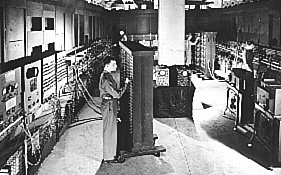
General View of the ENIAC, 1946.
It is not accurate to say that the ENIAC (Electrical Numerical Integrator And Calculator) as the first electronic computing device. Various devices which employed vacuum tubes were already available, such as radiation counters, ring counters, etc. , which employed vacuum tubes. The ENIAC, however, was the first all-purpose digital electronic computer, and it was at least ten to a hundred times as fast as anything available at the time. The basic idea is due to John W Mauchly (1907-1980), who in the summer of 1942 drafted a memo outlining the general architecture of a new machine which would perform general numerical calculations. Mauchly, although he was interested in meteorology and cryptography, was careful to recognize that the war effort required that the machine be able to perform ballistics calculations as well. The draft memo led to a formal proposal, which was read, among others, by Lt Herman Goldstine of the Ordnance Ballistic Research Laboratories, Aberdeen Proving Ground in Maryland, US. Goldstine had a PhD in applied mathematics from the University of Chicago, and was immediately impressed by the the computational possibilities of the machine proposed by Mauchly. A formal proposal was file in April, 1943, and a contract was awarded, Project PX, which resulted in the ENIAC. The credit for the ENIAC, however, goes equally to a young graduate student and laboratory assistant of Mauchly's, J Presper Eckert (1919-1995), who "possessed the engineering skills to bring the idea to life, and who in fact became the main project engineer."
ENIAC: Accumulator Decade Plug-in Unit
"A decision which was later seen to be critical to the project, was Eckert's insistence on top quality circuit design rather than expensive, high quality components. Although he permitted bodges and 'alternative' means of achieving the systems aims, he required all components used to have a massive margin of error, where ever possible ensuring that the components could withstand double the punishment they would be put through, and were twice as accurate as required. Also, he ensured the design was as simple as possible—the number stores for example, were direct electronic simulations of the wheels used in many of the mechanical systems."
[ from The Electronic Numerical Integrator And Computer ]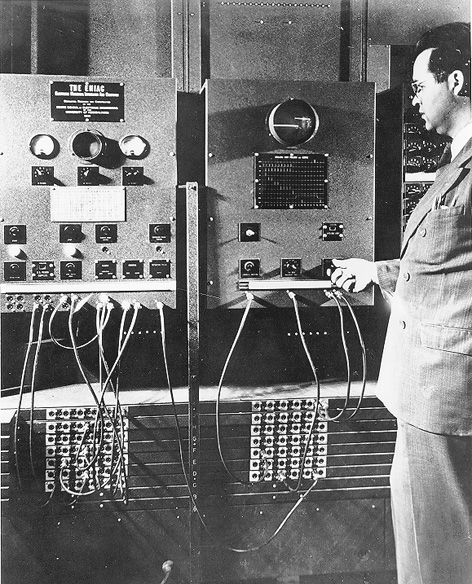
The Initiating and Cycling Units of ENIAC
"The ENIAC was a large-scale, general purpose digital electronic computer. Built out of some 17,468 electronic vacuum tubes, ENIAC was in its time the largest single electronic apparatus in the world. There were two fundamental technical innovations in the ENIAC. The first had to do with combining very diverse technical components and design ideas into a single system that could perform 5,000 additions and 300 multiplications per second. Although slow by today's standards—current microprocessors perform 100 million additions per second—this was two to three orders of magnitude (100 to 1,000 times) faster than existing mechanical computers or calculators. The sheer speed of the machine and its limited, but sufficiently versatile, programming mechanisms allowed the ENIAC to demonstrate that electronic computing could be applied to some of the nation's most pressing problems…" It is interesting to note here that a group of students in the Department of Electrical Engineering of the Moore School of Electrical Engineering, at the University of Pennsylvania "have designed the 'ENIAC(TM)-on-a-Chip,' [ … ] They have integrated the whole ENIAC on a 7.44 by 5.29 sq. mm chip using a 0.5 micrometer CMOS technology. [ … ] The chip has a size of 7.44mm by 5.29mm and contains about 174,569 transistors." [ from ENIAC-on-a-Chip ]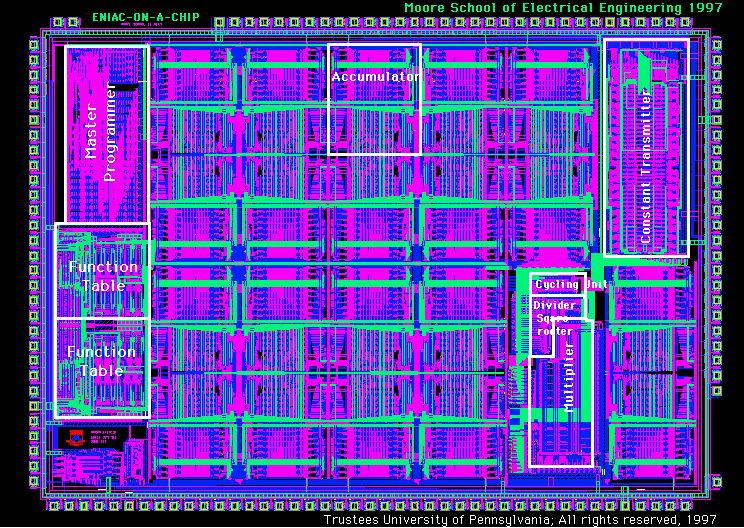
The ENIAC-on-a-Chip.
"The second, and equally impressive, technical achievement was the machine's reliability. Many others working on large-scale precision machinery, such as electronic fire control systems and differential analyzers, considered the possibility of electronic computation before either Mauchly or Atanasoff. These scientists, however, rejected digital electronic computing, because they felt that a system large enough to do useful computations would require too many vacuum tubes to provide reliable operation. As the main project engineer for the ENIAC, J Presper Eckert proved to be an outstanding engineer who overcame the most difficult technical challenges in building the ENIAC. The rigorous vacuum tube reliability studies that he oversaw and the cautious reliability design methods adopted by the entire ENIAC project team made it possible to operate the ENIAC, with all of its vacuum tubes, within a comfortable margin of reliability." [ from The ENIAC ] - Two concluding observations made by Williams [op. cit., p. 277 and p. 282-3]: "It is interesting to compare each of ENIAC's functional units with those of the Harvard Mark I. In almost every case it is possible to see that the ENIAC's unit was simply the electronic analog of the Mark I's electromechanical mechanism." " The ENIAC was never intended to be a computer with an internally stored program. Indeed, although it was developed shortly afterwards, the idea of an internally stored program was not even known when Mauchly made his first tentative suggestions about constructing an electronic calculating machine. It is a strange twist of fate, therefore, that the ENIAC actually did most of its work while operating as a stored program computer. In 1947 Richard F Clippinger, head of the Computer Laboratory at the Ballistic Laboratory, was able to show that the ENIAC could be converted to operate as a stored program computer…"
-
The first computer to be designed as a stored program machine was the EDVAC
(Electronic Discrete Variable Automatic Computer).
The famous
 First Draft of a Report on the EDVAC
by John von Neumann (June 30, 1945) is the first description of a method for storing both data and program in memory.
(Note that the size of the pdf file is 9.8MB, and that unfortunately the text and the illustrations are not very legible.)
It is a draft, and perhaps this explains why it is authored only by von Neumann, even though
the idea of program storage had been arrived by the group which included not only von Neumann,
but also John Mauchly, Presper Eckert, Herman Goldstine, and others. See also 1945 AD Von Neumann writes the 'First Draft'.
First Draft of a Report on the EDVAC
by John von Neumann (June 30, 1945) is the first description of a method for storing both data and program in memory.
(Note that the size of the pdf file is 9.8MB, and that unfortunately the text and the illustrations are not very legible.)
It is a draft, and perhaps this explains why it is authored only by von Neumann, even though
the idea of program storage had been arrived by the group which included not only von Neumann,
but also John Mauchly, Presper Eckert, Herman Goldstine, and others. See also 1945 AD Von Neumann writes the 'First Draft'.
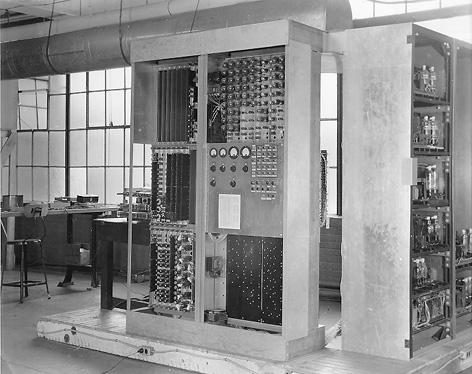
The EDVAC (ca. 1948)
In his draft, von Neumann listed the basic requirements the new machine should meet [ from EDVAC ]:- "Since the device is primarily a computer it will have to perform the elementary operations of arithmetic most frequently. Therefore, it should contain specialized organs for just these operations, i.e., addition, subtraction, multiplication, and division.
- The logical control of the device (i.e., proper sequencing of its operations) can best be carried out by a central control organ.
- A device which is to carry out long and complicated sequences of operation must have a considerable memory capacity.
- The device must have organs to transfer information from the outside recording medium of the device into the central arithmetic part and central control part, and the memory. These organs form its input.
- The device must have organs to transfer information from the central arithmetic part and central control part, and the memory into the outside recording medium. These organs form its output."
-
To get an idea of the range of problems the EDVAC was used for at the Ballistic Research Laboratory, consider
this list [ from EDVAC ]:
- "Exterior ballistics problems such as high altitude, solar and lunar trajectories, computation for the preparation of firing tables, and guidance control data for Ordnance weapons, including free-flight and guided missiles.
- Interior ballistics problems, including projectile, propellant and launcher behavior, e.g., physical characteristics of solid propellants, equilibrium composition and thermodynamic properties of rocket propellants, computation of detonation waves for reflected shock waves, vibration of gun barrels and the flow of fluids in porous media.
- Terminal ballistics problems, including nuclear, fragmentation, and penetration effects in such areas as explosion kinetics, shaped charge behavior, ignition, and heat transfer.
- Ballistic measurement problems, including photogrammetric, ionospheric, and damping of satellite spin calculations, reduction of satellite doppler tracking data, and computation of satellite orbital elements.
- Weapon systems evaluation problems, including antiaircraft and antimissile evaluation, war game problems, linear programming for solution of Army logistical problems, probabilities of mine detonations, and lethal area and kill probabilities of mine detonations, and lethal area and kill probability studies of missiles."
-
I will conclude this lecture with a brief survey of the Colossus machines. One of the
best and most complete sources of information on these machines, and the famous German Enigma which
the Colossus was designed to break, is Tony Sale's Codes and Ciphers
in the Second World War: The History, Science and Engineering of Cryptanalysis in World War II. Sale is the founder and original curator
of the Bletchley Park Museum. Visit also Station X, the official Bletchley
Park wbsite. Two other useful references are Critical Cryptanalysis: The Enigma War 1939-1942
from The Alan Turing Internet Scrapbook, and
David Hamer's The Enigma Machine.
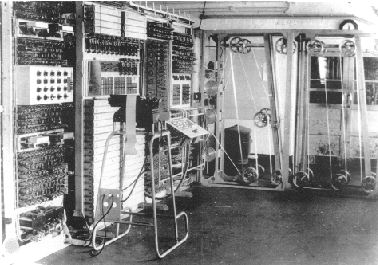
The Mark 1 Colossus Electronic Computer (March 1943)
-
The Enigma has a long history. It was first introduced on the market around 1927 by the
Lorenz company, in two versions: commercial and military. The military model featured an extra 'plugboard' which
increased substantially the number of possible encryption schemes. In 1928 "the German military
began to use Enigma code on one of their radio stations and Polish radio operators alerted the
Cipher Bureau to this fact. The Polish Cipher Bureau simply purchased a commercial copy of the
Enigma, modified it with the military pluhboard, and started to see if they could use it to
break the code." [ Williams, op.cit., p. 285 ]. It took a lot of effort, and the dedication of
Marian Rejewski, a mathematician, but by 1932 the Cipher Office "was able to break about 75% of
all German messages," keeping roughly pace with the continuous improvements of the Enigma by
the Germans. The Polish machines, called bombas, were eventually sent to the UK
(Bletchley Park) at about the time Poland was invaded. However, it became soon clear that
the bombas were inadequate and too slow: the Enigma had been perfected to the point
where new solutions needed to be found. It was at this time that Alan Turing
was called to Bletchley Park to lead a concerted effort to crack the Emigma code.
"Together with another mathematician W G Welchman, Turing developed the Bombe, a machine based
on earlier work by Polish mathematicians, which from late 1940 was decoding all messages sent by
the Enigma machines of the Luftwaffe. The Enigma machines of the German navy were much harder to break
but this was the type of challenge which Turing enjoyed. By the middle of 1941 Turing's statistical
approach, together with captured information, had led to the German navy signals being decoded at
Bletchley.
From November 1942 until March 1943 Turing was in the United States liaising over decoding issues
and also on a speech secrecy system. Changes in the way the Germans encoded their messages had meant that
Bletchley lost the ability to decode the messages. Turing was not directly involved with the successful
breaking of these more complex codes, but his ideas proved of the greatest importance in this work.
Turing was awarded the O.B.E. in 1945 for his vital contribution to the war effort."
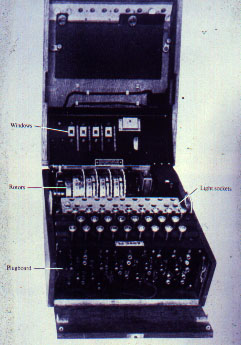
An Enigma Machine
- The first new machine, built under the direction of Max Newman and Wynn-Williams, was the Heath Robinson in 1943. This was followd a year later by the first Colossus, realized by Tommy Flowers and his team. "The Heath Robinson was a combination electronic and relay-based machine. The high speed accumulators were implemented in vacuum tubes while the slower functions, even including some of the high-order digits of the accumulators, were constructed out of relays." This machine was not very reliable. "The machine did, however, prove that it was possible to construct high-speed electronic devices which would help the decoding process…" [ Williams, op.cit., p. 290-1 ]
-
Flowers proceeded than to a complete redesign of the Heath Robinson, and built a completely electronic machine,
the Colossus The name was probably a reflection of the fact that the number of vacuum tubes used, 1500.
was far greater than in any other electronic device of the time (the ENIAC being the exception). "Before the
end of the war, several more Colossi were in use at Bletchley Park. It may be that as many as ten were fully functional
by the time the war was over. By utilizing parallel circuitry, the effective speed of the Colossus was increased
to deal with operations on 25,000 characters per second." Of course the Colossus was a special purpose machine.
Notice finally that, even today, not much is known about these machines because of the secrecy that surrounded them.
"It is known that at least one group of British RAF radio technicians were moved, after the war was over, to northern
Iran in order to intercept coded Russian radio messages. Thus it seems likely that the Colossi continued to be used for
code-breaking functions until they were replaced by more modern computers."[ Williams, loc.cit., p. 292 ]
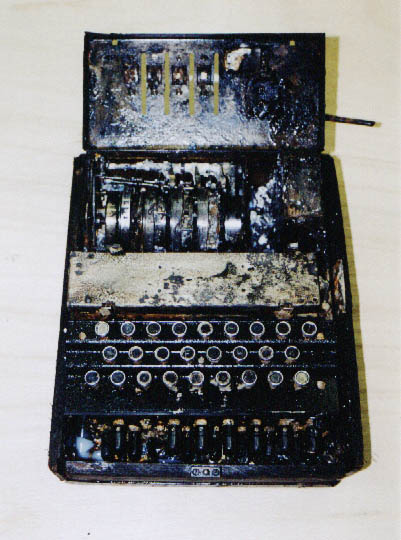
The Enigma Machine Recovered from U-Bot U85
Readings, Resources and Questions
-
For a rather detailed historical background of the ENIAC, somewhat biasied toward a military angle and the role of war in the
development of modern computing, see
 The ENIAC Story,
by Martin H Weik, 1961, Ordnance Ballistic Research Laboratories, Aberdeen Proving Ground. This is part of a broader account,
History of Computing Information, assembled by Mike Muuss
from the archives of The US Army Research Lab.
The ENIAC Story,
by Martin H Weik, 1961, Ordnance Ballistic Research Laboratories, Aberdeen Proving Ground. This is part of a broader account,
History of Computing Information, assembled by Mike Muuss
from the archives of The US Army Research Lab.
-
Other useful sources of information on tne history of the ENIAC are:
- John W Mauchly and the Development of the ENIAC Computer by Asaf Goldschmidt and Atsushi Akera, Department of History and Sociology of Science, University of Pennsylvania.
- The ENIAC, by Kevin W. Richey.
- Inventors of the Modern Computer: The ENIAC I Computer, J Presper Eckert and John Mauchly by Mary Bellis.
- The Women of ENIAC by Cynthia Soulliere.
- The Eniac Programmers, by Kathryn A Kleiman.
- Enigma-E offers "a DIY Building Kit that enables you to build your own electronic variant of the famous Enigma coding machine that was used by the German army during WWII. It works just like a real Enigma and is compatible with an M3 and M4 Enigma as well as the standard Service Machines. A message encrypted on, say, a real Enigma M4 can be read on the Enigma-E and vice versa."
- Read Return of Colossus marks D-Day. "Colossus Mk2, a wartime code-breaker hailed as one of the first electronic computers, has been rebuilt and reunited with Bletchley Park veterans."
© Copyright Luigi M Bianchi 2001, 2002, 2003
Picture Credits: IEEE Computer Society · Naval Historical Center
Penn Library · Moore School of EE
Last Modification Date: 02 June 2004
Picture Credits: IEEE Computer Society · Naval Historical Center
Penn Library · Moore School of EE
Last Modification Date: 02 June 2004